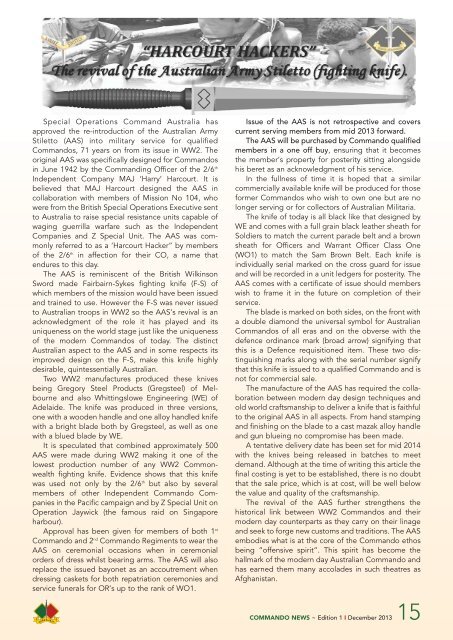AUSTRALIAN COMMANDO ASSN (NSW) INC.
You also want an ePaper? Increase the reach of your titles
YUMPU automatically turns print PDFs into web optimized ePapers that Google loves.
Special Operations Command Australia has<br />
approved the re-introduction of the Australian Army<br />
Stiletto (AAS) into military service for qualified<br />
Commandos, 71 years on from its issue in WW2. The<br />
original AAS was specifically designed for Commandos<br />
in June 1942 by the Commanding Officer of the 2/6 th<br />
Independent Company MAJ ‘Harry’ Harcourt. It is<br />
believed that MAJ Harcourt designed the AAS in<br />
collaboration with members of Mission No 104, who<br />
were from the British Special Operations Executive sent<br />
to Australia to raise special resistance units capable of<br />
waging guerrilla warfare such as the Independent<br />
Companies and Z Special Unit. The AAS was com -<br />
monly referred to as a ‘Harcourt Hacker” by members<br />
of the 2/6 th in affection for their CO, a name that<br />
endures to this day.<br />
The AAS is reminiscent of the British Wilkinson<br />
Sword made Fairbairn-Sykes fighting knife (F-S) of<br />
which members of the mission would have been issued<br />
and trained to use. However the F-S was never issued<br />
to Australian troops in WW2 so the AAS’s revival is an<br />
acknowledgment of the role it has played and its<br />
uniqueness on the world stage just like the uniqueness<br />
of the modern Commandos of today. The distinct<br />
Australian aspect to the AAS and in some respects its<br />
improved design on the F-S, make this knife highly<br />
desirable, quintessentially Australian.<br />
Two WW2 manufactures produced these knives<br />
being Gregory Steel Products (Gregsteel) of Mel -<br />
bourne and also Whittingslowe Engineering (WE) of<br />
Adelaide. The knife was produced in three versions,<br />
one with a wooden handle and one alloy handled knife<br />
with a bright blade both by Gregsteel, as well as one<br />
with a blued blade by WE.<br />
It is speculated that combined approximately 500<br />
AAS were made during WW2 making it one of the<br />
lowest production number of any WW2 Common -<br />
wealth fighting knife. Evidence shows that this knife<br />
was used not only by the 2/6 th but also by several<br />
members of other Independent Commando Com -<br />
panies in the Pacific campaign and by Z Special Unit on<br />
Operation Jaywick (the famous raid on Singapore<br />
harbour).<br />
Approval has been given for members of both 1 st<br />
Commando and 2 nd Commando Regiments to wear the<br />
AAS on ceremonial occasions when in ceremonial<br />
orders of dress whilst bearing arms. The AAS will also<br />
replace the issued bayonet as an accoutrement when<br />
dressing caskets for both repatriation ceremonies and<br />
service funerals for OR’s up to the rank of WO1.<br />
Issue of the AAS is not retrospective and covers<br />
current serving members from mid 2013 forward.<br />
The AAS will be purchased by Commando qualified<br />
members in a one off buy, ensuring that it becomes<br />
the member’s property for posterity sitting alongside<br />
his beret as an acknowledgment of his service.<br />
In the fullness of time it is hoped that a similar<br />
commercially available knife will be produced for those<br />
former Commandos who wish to own one but are no<br />
longer serving or for collectors of Australian Militaria.<br />
The knife of today is all black like that designed by<br />
WE and comes with a full grain black leather sheath for<br />
Soldiers to match the current parade belt and a brown<br />
sheath for Officers and Warrant Officer Class One<br />
(WO1) to match the Sam Brown Belt. Each knife is<br />
individually serial marked on the cross guard for issue<br />
and will be recorded in a unit ledgers for posterity. The<br />
AAS comes with a certificate of issue should members<br />
wish to frame it in the future on completion of their<br />
service.<br />
The blade is marked on both sides, on the front with<br />
a double diamond the universal symbol for Australian<br />
Commandos of all eras and on the obverse with the<br />
defence ordinance mark (broad arrow) signifying that<br />
this is a Defence requisitioned item. These two dis -<br />
tinguishing marks along with the serial number signify<br />
that this knife is issued to a qualified Commando and is<br />
not for commercial sale.<br />
The manufacture of the AAS has required the colla -<br />
boration between modern day design techniques and<br />
old world craftsmanship to deliver a knife that is faithful<br />
to the original AAS in all aspects. From hand stamping<br />
and finishing on the blade to a cast mazak alloy handle<br />
and gun blueing no compromise has been made.<br />
A tentative delivery date has been set for mid 2014<br />
with the knives being released in batches to meet<br />
demand. Although at the time of writing this article the<br />
final costing is yet to be established, there is no doubt<br />
that the sale price, which is at cost, will be well below<br />
the value and quality of the craftsmanship.<br />
The revival of the AAS further strengthens the<br />
historical link between WW2 Commandos and their<br />
modern day counterparts as they carry on their linage<br />
and seek to forge new customs and traditions. The AAS<br />
embodies what is at the core of the Commando ethos<br />
being “offensive spirit”. This spirit has become the<br />
hallmark of the modern day Australian Commando and<br />
has earned them many accolades in such theatres as<br />
Afghanistan.<br />
<strong>COMMANDO</strong> NEWS ~ Edition 1 I December 2013 15

















